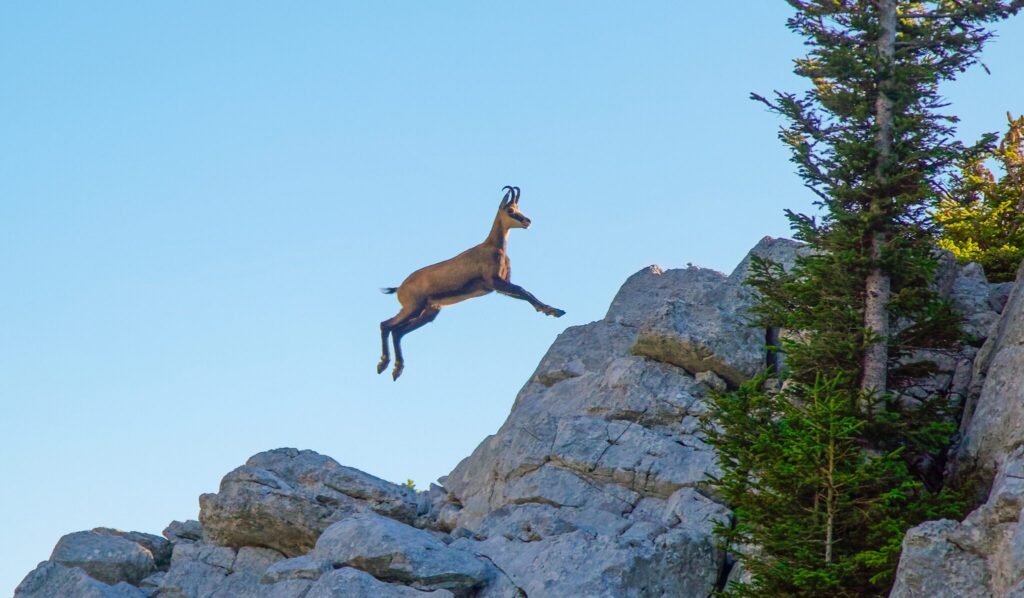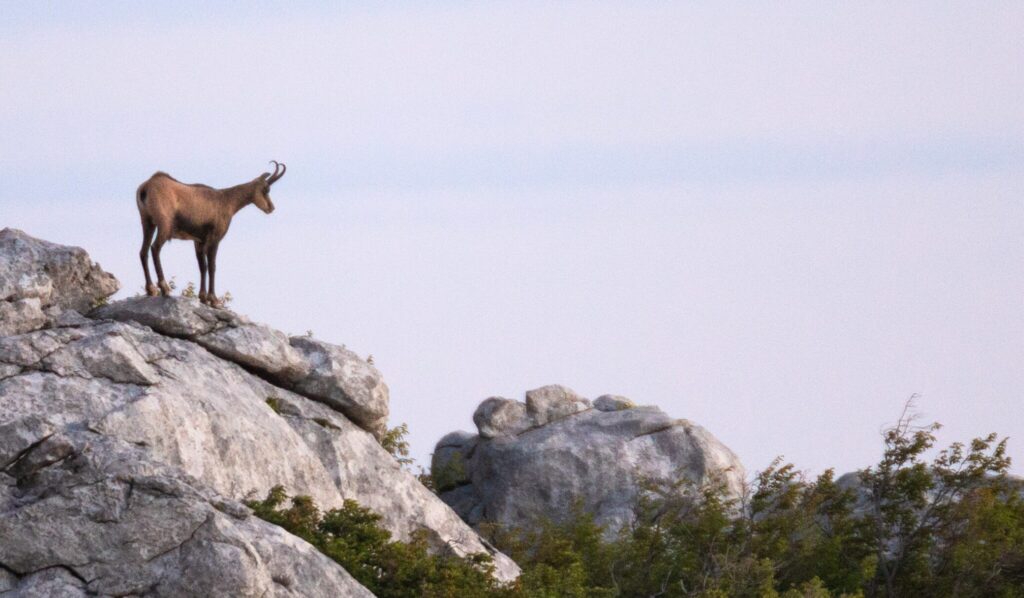It is now five decades since the first chamois were reintroduced in the Velebit area, and the speies has been continuously present here ever since. While the chamois population in Velebit is gradually increasing, there is room and reason to increase numbers further, as well as increasing the amount of habitat that could support this iconic and ecologically important animal.

The chamois (Rupicapra rupicapra) is perfectly suited to life in Velebit – its legs are strong and sturdy, its hooves flexible, and its bones light and porous, allowing it to move easily and gracefully even on very inhospitable terrain, including steep slopes. It is robust and compact, capable of running at speeds up to 50 km/h, jumping two metres high, and up to six metres in distance.
The chamois inhabits high mountain meadows above the upper forest boundary, adjoining rocky and steep slopes where it rests and finds protection from predators. It also inhabits dense mountain forests – little disturbed areas with abundant grass that offer shelter from weather and predators.
Life above 400 meters
It is not particularly demanding when it comes to food. In summer, it feeds on grasses, herbaceous plants, and berries, while in winter, it survives on lichen, moss, and tree shoots. It enjoys strong aromatic grasses and licks salt, drinking water only occasionally. Typically, it lives at altitudes from 400 to 3,000 metres, moving to lower regions in winter, to areas covered with shrubs and trees where it can more easily access food due to shallower snow cover. If an area provides enough food and refuge from predators and disturbance, the typical range of a chamois herd can extend from 100 to 300 hectares.

As a herbivore, the chamois maintains mountain grasslands through natural grazing, promoting biodiversity, and providing a source of food for predators such as wolves, foxes, jackals, lynx, and bears, while young chamois are also preyed on by eagles. The chamois is a distinctly diurnal animal, active from dawn to dusk, though it may rest during the day in hot weather. It spends nights in safe, quiet places. It communicates in various ways – bleating (between chamois and kids), whistling to warn of potential danger (along with foot stomping), and crying out when injured. With an exceptional sense of hearing and smell, it can detect predators from up to a kilometre away if the wind is favorable. It also has excellent vision, making it almost impossible to approach a chamois unnoticed in open terrain.
Both males and females have permanent horns
Belonging to the family Bovidae, its horns never shed but continue to grow throughout its life. The horn is a product of the skin, consisting of a horn core (porous bone), nerve, and keratin (hardened skin). Both males and females are recognizable by their slender, black horns that curve backward at the tip, though males’ horns are more curved, thicker towards the head, and form a hook.
The chamois has a short, brown summer coat, up to 3 cm long, and a thicker, greyish winter coat, up to 12 cm long. Along its back, a long dark stripe with hair up to twenty centimeters stretches along the spine. Its head is lighter than the rest of the body, with dark stripes extending from below the eyes almost to the snout. Males have a pronounced beard or fin – a strip of longer hair along the back. Males are also characterized by a tuft on the belly and a stronger, thicker neck.

Herds of 15 to 30 individuals consist of females, kids, and young males up to two years old, led by an old, experienced doe. Herds have lookout “guards” that warn the rest of the herd of danger by stomping and whistling. Males over three years old live alone, but join other chamois in the autumn at the start of the mating season (called rutting), when herds can grow to 100 individuals.
November is a time of fierce battles between males for females, with one male potentially fertilizing multiple females. During mating, males’ postauricular glands swell and secrete an intense-smelling substance to mark territory. After 21-22 weeks, the female separates from the herd to give birth to one, sometimes two, kids in May or June. The kid can walk and follow their mother over difficult terrain within a few hours of birth. The mother nurses them for the next 2-3 months, and stays with them for the entire year. When young males attract a certain number of young females in search of new habitats, new herds form, leading to lateral population expansion.
The taller and heavier Velebit chamois
On the Balkan Peninsula, a special subspecies of chamois (Rupicapra rupicapra balcanica) exists. This is taller and heavier than the Alpine chamois (Rupicapra rupicapra alpina) due to mild winters and little snow, resulting in lusher, more abundant food.
The Alpine chamois disappeared from the Velebit area at the beginning of the 20th century, with ten individuals released in 1974 and another five in 1978. They originated from the Kamnik-Savinja Alps (Slovenia, northern chamois) and Prenj (Bosnia and Herzegovina, Balkan chamois), resulting in hybrid individuals, which have been genetically and scientifically confirmed and published in a scientific magazine Journal of Wildlife Management. Although some studies show that the gene of the Balkan chamois never disappeared from the Velebit area, the local population is considered “common chamois,” Rupicapra rupicapra, and has game status, which means it is legal to be hunted.

The chamois in Velebit and other parts of Croatia have repeatedly come close to extinction throughout history. However, the Velebit area, with its meadows, forests, clearings, rocks, and altitude, is an ideal habitat for the chamois, and it is estimated that up to two thousand individuals could live in this massif alone. It is also estimated that around 860 chamois live on Velebit and the population is increasing, with poaching being the biggest threat. Potential repopulation, or the introduction of additional chamois individuals, aims to increase their numbers, prevent inbreeding, and improve the population’s health and fitness, thus enhancing their chances for healthy development and long-term survival. Increasing the number of chamois in Velebit would also raise the likelihood of connecting the Velebit chamois population with the Alpine population, strengthening both and potentially resulting in the expansion of the chamois habitat to areas between these populations.
Text: Kruno Bošnjaković